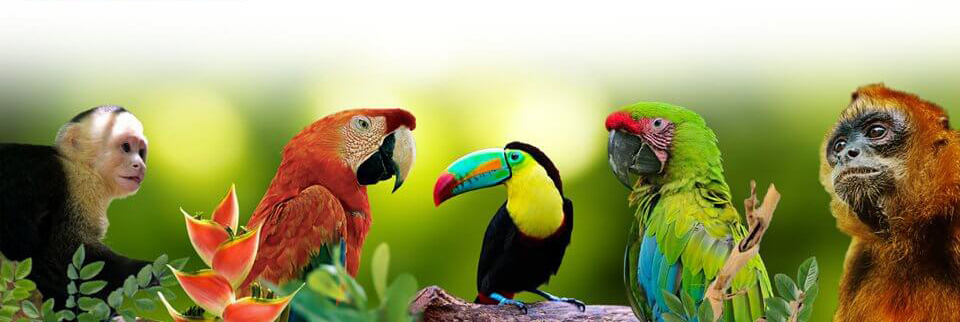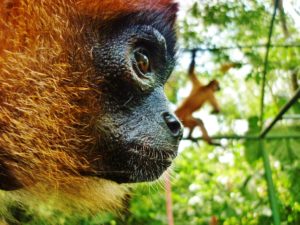Any visitors to Proyecto Asis will quickly become aware of one wonderful fact – Costa Rica has a truly incredible range of amazing wildlife. Costa Rica is incredibly lucky to have this rich biodiversity – and even luckier that the species it harbors are so very fascinating and appealing. Costa Rica is considered to have the highest biodiversity density of any country in the world, and most people rightly believe that this should be protected. However, this is not universally the case. Unscrupulous individuals are threatening not only the biodiversity of Costa Rica, but its entire ecosystem through the particularly loathsome crime of wildlife trafficking.
Serious Ecological Consequences
Costa Rica’s biodiversity is the pride of the world – but it also attracts plenty of less than savory individuals and cartels who want to use Costa Rica’s wildlife for their own gain. Wildlife trafficking – the removal of animals from the wild and selling them on – is a big problem for Costa Rica’s native species. While most international pet stores source their animals ethically and never take from the wild, there nonetheless exists a thriving black market in exotic animals, which is depleting Costa Rica’s natural stock considerably. Indeed, wildlife trafficking is thought to be the biggest threat to the Costa Rican ecosystem, after habitat depletion. This is very serious. If too many of any species is taken from the wild, the effects will reverberate right through the ecosystem, causing potentially catastrophic effects. As such, it is crucial to crack down on wildlife trafficking in Costa Rica before it is too late.
A Profitable Market
Wildlife trafficking is thought to be an incredibly lucrative worldwide industry. It follows drugs and weapons trafficking to come in as the third most lucrative form of smuggling, pipping human trafficking to the post. The ‘industry’ in its entirety is estimated to be worth an incredible $10 billion a year. It is these riches which undoubtedly attract the cruel individuals who participate in the actual trafficking itself. However, it is worth noting that the traffickers would very quickly go out of ‘business’ if no market for their wares existed. Many animals stolen from the wild in Costa Rica end up as household pets, and the demand for exotic, cute, and dangerous species for people to keep in their homes and show off to their friends is high. People always have been and always will be fascinated by animals – this is what makes zoos and wildlife documentaries such infallibly popular attractions. Costa Rica’s wealth of fauna makes it a prime target for wildlife smugglers, capturing such creatures for those who would possess them personally and exclusively. It would seem, therefore, that the best way to eliminate the trade is to eliminate the market.
The Turning Tide
This is where organizations like Proyecto Asis come in. Proyecto Asis helps to combat wildlife trafficking at a grassroots level by educating people about wildlife, and explaining why it’s best left in the wild. The project satiates people’s desires to get close to native Costa Rican fauna, while simultaneously discouraging them from the need to personally possess any such creatures. Initiatives like Proyecto Asis are, slowly, changing people’s opinions about wildlife, the environment, and how we interact in general with other species. This, in turn, is changing the world. Grassroots education about the environment can make a huge difference. The vacation industry, for example, once one of the least environmentally friendly businesses on the planet, is turning to ‘ecotourism’, because consumers – now wise in the ways of ecological science – are not only interested in the environment, but refuse to take a vacation that harms it. Indeed, in countries like the UK, people are choosing to go for ‘cheap and cheerful’ eco-vacations rather than splashing out on more expensive luxury tours, feeling that the environment is worth the drop in comfort. Ecotourism is particularly popular in Costa Rica, due in no small part to the influence of places like Proyecto Asis. If we can teach people to respect wildlife and its right to remain wild, then the bottom will eventually drop out of the trafficking industry, and millions of species will be saved.
Work Still To Do
However, there is a long way to go yet. A mere three months ago, Costa Rican officials deported a German tourist who was caught trying to smuggle over 400 reptiles and amphibians out of the country. The poor things were stuffed into takeout containers, and bound for exotic pet shops in Germany. Last year, a Canadian tourist was stopped at the airport with five live iguanas in her hand luggage, and in 2009, a man (German, again) attempted to board a plane with green parrots in his bag. These are only the colorful tales that make the news – many more animals are confiscated from passengers at customs every month, and countless more wild species are successfully smuggled from the country. Those who go on to buy the animals are probably unaware of their provenance, nor of the damage they are doing by funding the trafficking industry and providing a market for these creatures. If the issue is to be solved conclusively, we must raise awareness amongst ordinary people.
Sally James
London, England
Travel writer
January 2015

